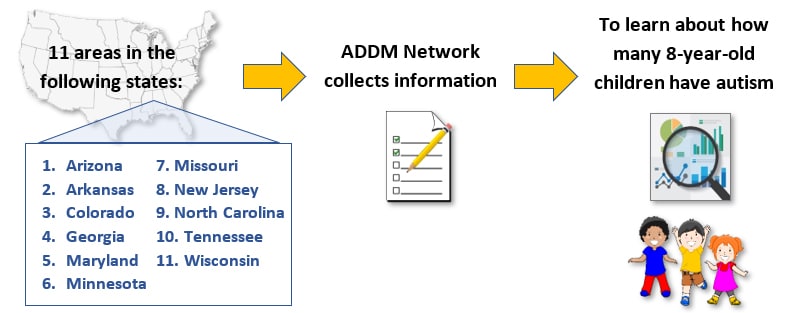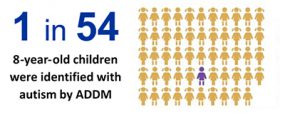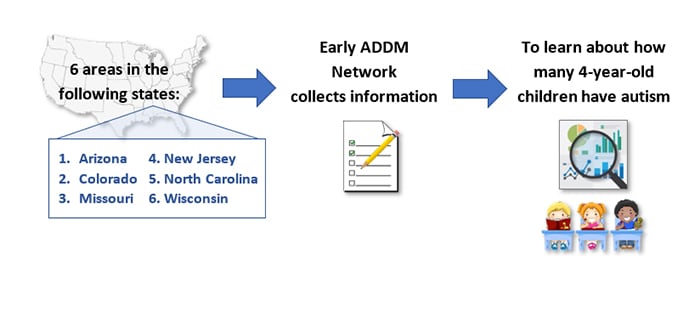Identifying Autism Among Children: An Easy-Read Summary
This is an Easy-Read Summary of two reports. The first report is about the number of 8-year-old children with autism. The second report is about identifying autism early among 4-year-old children.
The information in this Easy-Read Summary comes from
- Maenner M, Shaw K, Baio J, et al. (2020). Prevalence of Autism Spectrum Disorder Among Children Aged 8 Years – ADDM Network, 11 Sites, United States, 2016. Morbidity and Mortality Weekly Report (MMWR)..
- Shaw K., Maenner M, et al. (2020). Early Identification of Autism Spectrum Disorder Among Children Aged 4 Years – Early ADDM Network, 6 Sites, United States, 2016. Morbidity and Mortality Weekly Report (MMWR).
- What is autism?
Autism is a developmental disability. A person with autism has trouble communicating or understanding what other people think or feel. People with autism focus on or do the same thing over and over again. - What is CDC?
The Centers for Disease Control and Prevention (CDC) is a federal government public health agency. CDC answers urgent health questions. - How does CDC study autism?
- CDC helps track the number of people in certain parts of the United States who have autism. Scientists call this number “prevalence.” Prevalence is a percent or ratio. It is a number that says: “Of all the children in the country, how many are like this?”
- CDC works to understand if some children are more likely to have autism than other children.
- CDC is working to understand if some children are diagnosed, or identified, with autism earlier than others.
- CDC is working to understand if there are factors that might put a child at risk for having autism.
- Where did the information for the studies described in this Easy-Read Summary come from?
The information for these studies came from CDC’s Autism and Developmental Disabilities Monitoring Network, or “ADDM.”- ADDM is a group of programs that keeps track of the number of children with autism in different areas of the United States.
- The information from ADDM helps CDC do these three things: (1) know more about the children with autism, (2) identify patterns over time, and (3) learn if autism is more common in some groups of children.
Here is the information from the two reports described in this Easy-Read Summary.
Report #1
The following information is about the study described in the report:
Prevalence of Autism Spectrum Disorder Among Children Aged 8 Years–ADDM Network, 11 Sites, United States, 2016
- What was this study about?
- For this study, ADDM collected information on 8-year-old children whose parents or guardians live in one of 11 different areas in the United States.
- This information helps us understand the number of 8-year-old children in these 11 areas who have autism.

- What information was collected?
A case definition is the set of criteria used to make a decision about whether there is a disease or condition present.
ADDM collected information on autism from medical and educational records. This information is then reviewed by experienced clinicians who decide if the information collected meets the case definition of autism.
- What did this study find?


More boys than girls were found to have autism.
Among 8-year-old children in the 11 ADDM areas
- For every 54 children living in the 11 ADDM areas, one child was found to have autism. This was a little more than what was found before (1 in every 59 children
- For each one girl found to have autism, four boys were found to have autism.
- No differences were found in the number of black children with autism compared to white children.
- Fewer Hispanic children were found to have autism than black, white, and Asian children.
- Black children with autism were less likely to be evaluated by the time they were 3 years old than white children with autism.
- Why are these findings important?
The ADDM Network is learning about whether certain children are more likely to be diagnosed with autism than other children. This information can help us find better ways to support these children and their families. This information can also help us make sure all children are evaluated as early as possible
Report #2
The following information is about the study described in the report:
Early Identification of Autism Spectrum Disorder Among Children Aged 4 Years–Early ADDM Network, 6 Sites, United States, 2016.
- What was this study about?
- The Early Autism and Developmental Disabilities Monitoring (Early ADDM) Network collects information about the number of 4-year-old children with autism. Early ADDM collects information from 6 areas in the United States.
- This gives scientists information about how children with autism are identified at a younger age. It also helps scientists understand how many 4-year-old children in the 6 areas were evaluated and diagnosed early.

- What did this study find?
Among 4-year-old children in the 6 Early ADDM areas

- More children were being evaluated by 3 years old. Evaluations are done to see how children are developing.
- 84% of 4-year-olds had received a first evaluation by the time they were 3 years old. This is higher than the 74% reported in an earlier study.
- There were more diagnoses of autism by age 4 among children born in 2012 compared to children born in 2008.
- Why are these findings important?
The earlier a child can be identified with autism, the sooner the child can receive services. These services can help the child develop important skills
What the Words Mean—Glossary
Autism is a developmental disability. A person with autism has trouble communicating or understanding what other people think or feel. People with autism focus on or do the same thing over and over again.
Autism and Developmental Disabilities Monitoring (ADDM) Network is a group of programs that keeps track of the number of children with autism in different areas of the United States.
Centers for Disease Control and Prevention (CDC) is a federal government public health agency that responds to urgent health concerns in the United States.
Developmental evaluation is the first test children should take before they are 3 years old to learn if they have early signs of autism. These screenings are done by a trained clinician.
Prevalence is a number that says: “Of all the people in the country, how many are like this?”
Development:
This Easy-Read Summary was developed using the Learning More about Health of People with Intellectual and Developmental Disabilities (IDD) as a guide:
Administration for Community Living (2019). Learning More about Health of People with Intellectual and Developmental Disabilities (IDD): An Easy Read Summary. Available at: How to improve health surveillance of people with IDD
Recommended Citation for this Easy-Read Summary:
National Centers on Birth Defects and Developmental Disabilities (2020). Identifying Autism Among Children: An Easy Read Summary. Available at: https://www.cdc.gov/ncbddd/autism/addm-community-report/an-easy-read-summary.html